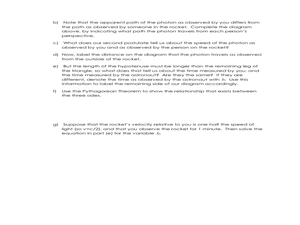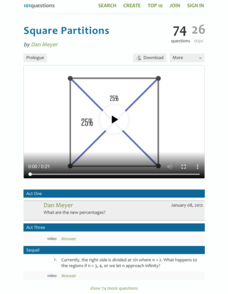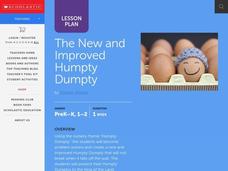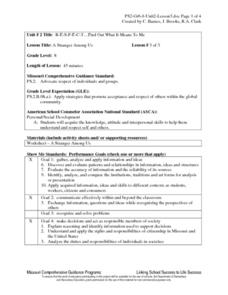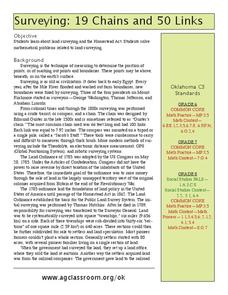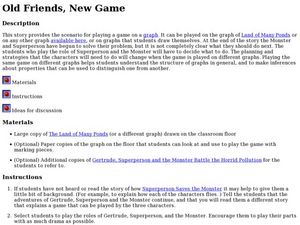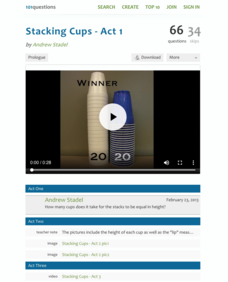101 Questions
Nana's Paint Mixup
You would probably do anything for your Nana, including fixing her mistakes! Nana provided the wrong ratio to mix red and white paint, and she didn't realize it until after she mixed the paint. Your class now needs to figure out how to...
101 Questions
Thanksgiving Taters
What would a meal be without the taters? The question is, how long does it take to peel those potatoes? Given the rate of peeling one potato, scholars predict the time it takes to peel the bag. The twist is that the first potato was...
Curated OER
Time Dilation and Geometry
Learners solve problems of dilation and velocity. In this geometry lesson, students apply the Pythagorean Theorem to solve problems and relate it to time and velocity.
101 Questions
Square Partitions
Challenge your classes while developing their problem-solving skills. A square is divided neatly into four equal triangles by its diagonals until one diagonal is moved from a vertex to the midpoint of one side. Now, scholars must devise...
101 Questions
Joulies
Does your coffee get too cold too fast? Joulies just might be your answer! Learners use experimental data to make a conclusion about how effective Joulies are at keeping coffee at the ideal temperature. A video shows the graph of the...
Curated OER
Reinforcing the Scientific Method
Seventh graders explore a variety of situations and make hypotheses before designing possible experiments. They then are presented with an experiment actually done to solve the original problem and compare it with their results. Students...
Illustrative Mathematics
Banana Pudding
Making banana pudding despite misplacing your one-cup measuring cup is easy as long as you can find your quarter-cup measuring cup! This real-life activity provides a good opportunity for learners to interpret division of a whole...
Curated OER
The New and Improved Humpty Dumpty
Learners help Humpty Dumpty. In this nursery rhyme lesson, students listen to the nursery rhyme and then use their problem solving skills to rebuild broken eggs. Learners create new Humpty Dumptys from unbreakable materials.
Yummy Math
Penny Wars
As the saying goes, a penny saved is a penny earned. Young scholars use a penny activity to earn their way to an understanding of volume. Given three different-sized cylindrical containers, individuals make calculations to determine the...
Curated OER
Retelling the African Folktale Abiyoyo
Act out the African folktale Abiyoyo. Kindergartners listen to the tale and discuss the characters, dressing as their favorite characters in order to retell and perform Abiyoyo using props. They will gain an understanding of...
It's About Time
Circular Motion
Lead your class in this exciting activity to learn more about motion and its importance. Pupils learn about a centripetal and why it is required to maintain a constant speed in a circulating moving mass. They apply the equation for...
101 Questions
Water Tank Filling
Grab your classes' attention with a video presentation of a problem to solve. Young scholars develop a plan to predict the time it takes to fill a tank with water. Video footage provides the statistics they need to make their conclusions.
Curated OER
A Stranger Among Us
Eighth graders give their own definition to the terms race, religion, culture, character and ethnicity and write them on the board. As a class, they discuss the differences and similiarties between the terms. In groups, they complete a...
Curated OER
It Counts
Students explore how numbers can identify objects. In this math lesson, students determine how numbers are used to describe objects used in quantitative data collection.
Curated OER
19 Chains and 50 Links
Students investigate surveys as it relates to chains and links. In this math lesson plan, students relate math to history and surveys done above, below and on the earths' surface. They review vocabulary pertaining to this lesson plan...
Curated OER
It's in the Garbage
Students analyze how studying garbage relates to methods of archaeology. They examine garbage to determine things about their culture and relate that to prehistoric peoples.
Curated OER
What about Babuie's Behavior?
Students read the story about Babuie's behavior and relate it to a finite state machine. In this language arts instructional activity, students discuss and analyze their reading assignments. They develop a method to help them understand...
Curated OER
Old friends, New game
Students create characters from a book. In this Language arts lesson, the students act out the story by role playing. The students learn how to articulate correctly, by working together to arrive at the same destination.
101 Questions
Stacking Cups
Facilitate an understanding of equality using a modeling task. After watching different-sized cups being stacked, learners use their math skills to determine when the height of each cup tower will be the same. Meant as an introduction to...
Curated OER
America's Civil Rights Movement, Activity Ten
Students identify a wrong in their own community and act to correct it. They reflect on the intersection fo the Civil Rights Movemnet with a social justice project.
Curated OER
Colors and Trouble
Pupils discuss what it would be like if there weren't enough resources by reading " The Land of Many Colors." In this tolerance instructional activity, students identify the differences between tolerant and intolerant behavior. Student...
Cornell University
Beam Focusing Using Lenses
Explore optics using an inquiry-based experimental approach! Young scholars use a set of materials to design and build a unit capable of focusing a beam of light. They experiment with different lenses to determine the best approach to...
Curated OER
Engineering - Solid Rock to Building Block
Students role-play as engineers designing wedge tools. They devise methods for shaping quarry rocks into pyramid blocks. Following a teacher demonstration, they use materials such as soap, clay, and foam for blocks and wood, plastic,...
101 Questions
Pyramid of Pennies
Go big or go home! Learners watch a video rendition of the creation of a penny pyramid. Their task is to determine the number of pennies in the pyramid. The lesson encourages multiple methods, including function building or volume formulas.


